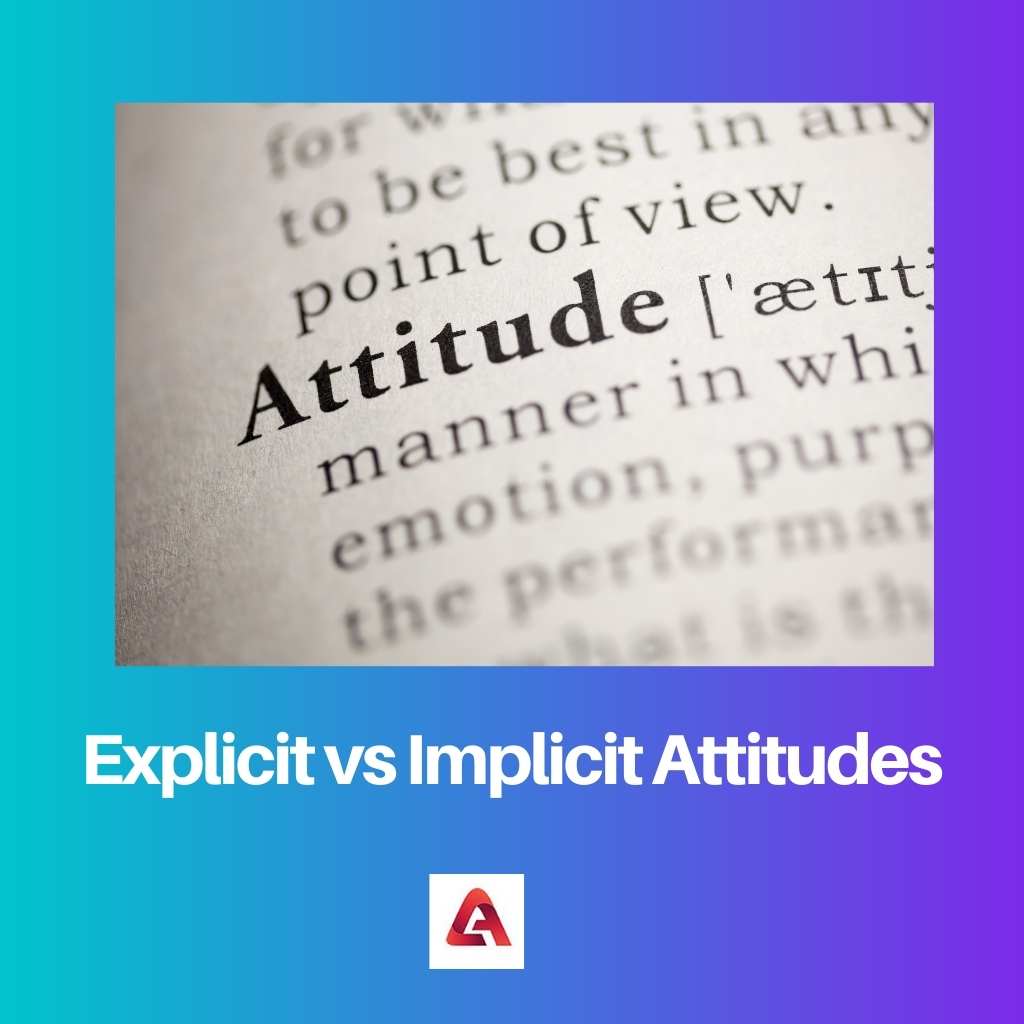In psychology, an attitude refers to different things such as your reaction to the situation, handling the situation, and experience plan for the future. Attitude can be of two types called Explicit and Implicit Attitude.
Attitudes are enduring, but they can also change over some time. In some cases, it may emerge directly due to personal experience or come from the result of observation.
Key Takeaways
- Explicit attitudes are conscious beliefs and opinions, while implicit attitudes are unconscious, automatic evaluations.
- Explicit attitudes can be easily articulated and measured through self-report, whereas implicit attitudes require indirect measures, such as the Implicit Association Test (IAT).
- Explicit attitudes are more susceptible to social desirability bias, whereas social expectations less influence implicit attitudes.
Explicit vs Implicit Attitudes
Explicit attitudes are attitudes that are consciously and intentionally held and can be expressed through self-report measures. Implicit attitudes are attitudes that are unconscious and automatic and may be influenced by experiences or associations that the person may not be aware of.

Explicit attitudes are at the conscious level. These are deliberately formed and easy to report. They can be observed by the outsider and are known to the subject.
The two most common methods to determine explicit attitudes are observation and self-reporting. They are a key construct in many behavioral theories. For health behavior, it is very relevant.
Implicit attitudes are automatically occurring attitudes. People are less aware of this and do not have conscious access. For accessing it, computerized reaction time is used.
The test is called Implicit Association Test. It comes from influenced experiences. These attitudes are not the result of direct personal experience.
The consequences of implicit attitude will vary, and many times negative consequences can also happen.
Comparison Table
| Parameters of Comparison | Explicit Attitudes | Implicit Attitudes |
|---|---|---|
| Definition | These are called deliberate and conscious attitudes. | These are automatic and unconscious attitudes. |
| Awareness | They are aware of explicit attitudes. | They are not aware of implicit attitudes. |
| Change | It is more dynamic, can easily change over time. | It is likely to be resistant to change. |
| Measurement | Direct measurement. | Indirect measurement. |
| Example | You can tell someone whether you like the food or not. | They are regularly exposed to negative ideas like old people and aging. |
What are Explicit Attitudes?
It is a kind of attitude that people deliberately think about and report.
Sometimes they are defined as conscious attitudes because these attitudes are deliberately formed so that people can self-report on their explicit attitudes.
These attitudes are constantly aware of, so they influence our behaviors and beliefs. We can find explicit attitudes by self-report questionnaires.
These can be suspectable to primary and recency effects and various cognitive biases.
It is tempered by social desirability. Since they occur at the conscious level, they exert intense effects on behavior and decision. This is the main reason as they are called deliberately formed attitudes.
This attitude is expressed irrespective of whether they are voluntary or involuntary. This kind of attitude is controllable.
This response can be altered over some time depending on the cognitive changes of an individual.
Explicit responses are associated with fast learning. It involves bipolar scales such as strong support to strongly oppose, very good to very bad, highly favorable to highly unfavorable.
It can be measured using self-testing and observing. It is more dynamic and malleable over time. It occurs primarily in newer and executable control structures of the frontal lobe.
It relies primarily on future outcome projections in working memory.
What are Implicit Attitudes?
These are evaluations that occur without any conscious awareness. It can be towards a self or an attitude object. Cultural conditioning, upbringing, and media portrayals will contribute to implicit associations.
These people are formed from the members of other social groups. The main purpose of implicit attitude is to make the response easier whenever a closely related item shares the key.
It is driven by the subconscious mind.
This attitude is largely recognized, although they strongly reflect the values of a person, underlying morals, and beliefs. Implicit attitude tests can be taken online on their official website.
All you need to do is simply refer to their website and take the test. It can blindside you from reality, making a decision, and could cause someone to make false judgments on someone.
In many cases, it makes people treat someone worse.
Negative implicit and subconscious bias unchecked always leads to a contempt response. They are measured with reaction time. If people come across any good product, then their response would be fast.
If they don’t like the product or it is bad, then their response would be bad, and it will be depicted as implicit behavior. Our reaction time simply infers our implicit attitudes.
Main Differences Between Explicit and Implicit Attitudes
- Explicit attitude people are always aware of explicit attitudes. On the other hand, implicit attitude people are not aware of implicit attitudes.
- The definition of explicit attitude is they are deliberate and conscious attitudes. On the other hand, the definition of implicit attitude is they are automatic and unconscious attitudes.
- Change in explicit attitude is more dynamic, and it can change over some time. On the other hand, a change in implicit attitude is likely resistant to change.
- Explicit attitudes use direct measurement. On the other hand, implicit attitudes use indirect measurement.
- An example of an explicit attitude is you can tell someone whether you like the movie or not. On the other hand, an example of implicit attitude is people are regularly exposed to negative ideas like old people and aging.
- https://www.sciencedirect.com/science/article/pii/S0022103103001665
- https://www.tandfonline.com/doi/abs/10.1080/10463280701489053
